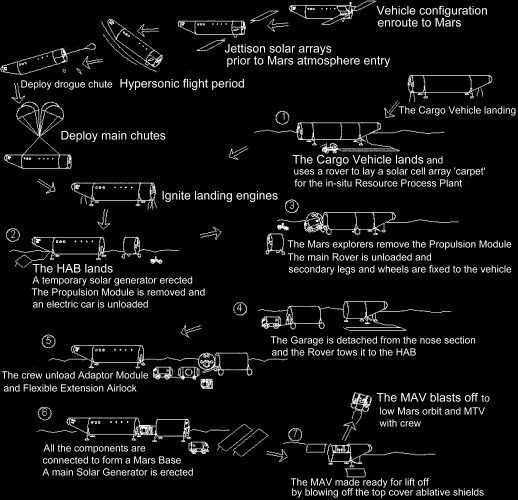Main menu
Mars-Oz
The centrepiece of MSA's technical program is the proposed Mars-Oz simulated Mars base. The aim of the simulated base is to explore the issues of living and working on another planet. This includes facilitating research into social-psychological factors and related engineering design of crewed missions to Mars or the Moon. In summary the project goals are:
- To provide planetary scientists access to a ‘Mars like’ region enabling opportunities to conduct research and training for planetary geologists and astro-biologists in field exploration and their related methodologies;
- To provide geologists, biologists, psychologists, physiologists, engineers, designers and horticulturalists a ‘test bed’ to research ideas, methodologies and equipment that can operate within the constraints of a base on Mars;
- To empirically test of the design advantages of using bent biconic lifting body shapes as a design basis for Mars bases. In particular, internal utility and accessibility of working spaces, and the mobility of the modules when wheels are attached;
- To trial and demonstrate technologies suitable for environmental low impact self-sustaining mobile structures; and
- To provide an inspirational public outreach vehicle encouraging planetary exploration and the education of public groups and school students into the science and technology of living on another planet.
The preferred site for the Mars-Oz simulated base is on the Arkaroola lease, Australia’s first and largest private nature preserve. The Sprigg family who run the property have a long history of supporting scientific research and eco-tourism. They are supportive of the establishment of a Mars analogue facility and the many visitors to the region provide an excellent opportunity for outreach. Arkaroola is eight hours by road north of Adelaide. In an emergency the all weather airstrip at Balcanoona would permit air evacuation by the Royal Flying Doctor Service. The same airstrip can also be used by charter operators.
An account of the site selection process which identified the Arkaroola region and detailed report describing the rationale for the specific site may be downloaded as a pdf document.
The facility consists of two 20 tonne road transportable modules designed around a concept mission using a 'Mars Semi Direct' architecture and horizontally landed bent iconic spacecraft. The facility is designed to house up to 8 people at any one time, and can undergo progressive expansion with additional modules, as required. A simulated Mars rover the Starchaser Marsupial is being built in Hobart, Tasmania and will form part of the base complex.
The Mars-Oz concept employs a Hab, a Cargo vehicle and Mars Transfer Vehicle (MTV). (The Mars Transfer Vehicle is not discussed here.) A summary of vehicle functions is given below.
- Habitat (Hab) - Travels to the Martian surface, direct from earth and becomes the core of the Mars base. It consists of a cabin, propulsion module, heat shield, landing engines and parachutes. Concept designs of the interior of the unit, include the floorplan and fittings have been prepared by Kerstin Thompson Architects. (See the links below to floor plans, sections and perspective images).
- Cargo Vehicle - Transports equipment to the Martian surface direct from earth 2 years prior to the arrival of the crew. The equipment consists of a Mars Ascent Vehicle (MAV) for the crew to reach low mars orbit, hydrogen stock fuel, an in-situ resource utilisation processing plant, a pressurised rover and surface supplies for the crew. It also has a propulsion module, heat shield, landing engines and parachutes.
- Mars Transfer Vehicle (MTV) - Travels to low Mars orbit from Earth. It transports the crew back to Earth from low mars orbit. It consists of a cabin, landing capsule with heat shield, and propulsion module for Earth return.
Technical drawings and perpective views showing configuration details of the proposed facility may be downloaded in pdf or jpg format by clicking on the links below.
Habitat & Garage Assembly
Habitat Floor Plans & Sections
Habitat 3D internal/external views
Habitat Transport Details
Garage Floor Plans
Animation by Kerstin Thompson Architects showing interior configuration
MSA Reports & Publications
MarsOz Mars Design Rationale (pdf) (0.5 Mb)
MarsOZ Proposal document-ver1b (pdf) (1.3Mb)
Addendum to MarsOZ Proposal document (pdf) (0.45 Mb)
Mars-Oz Mission Plan: A Practical Architecture for Exploration-Focused Manned Mars Missions Using Chemical Propulsion, Solar Power Generation and In-Situ Resource Utilisation. (pdf) (1.2 Mb)
MarsOz Information Leaflet (pdf) (0.5 Mb)
Arkaroola Geology Information Leaflet (pdf) (3.5 Mb)
MARS-OZ Analogue Research Station Subsystem Research and Development Project - ANU (pdf) (5 Mb)
Preliminary Design MarsOz Piglet (pdf)
MarsOz Habitat Garage Final Design Report (pdf)
Beyond the Mars-Oz Reference Mission (pdf)
The benefits of using simulated space suits
MARS Business and Technical Overview here.
(Please note this document is password protected)



